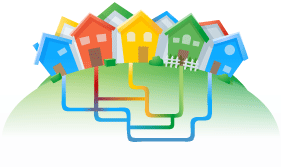(Cross-posted from the Public Policy Blog.)

Given how important broadband capability is to economic growth and job creation, it's no surprise that it's become a major topic of discussion in Washington.
The FCC is currently finalizing its National Broadband Plan to present to Congress next month. Recently
we suggested that as part of its Plan, the Commission should build ultra high-speed broadband networks as testbeds in several communities across the country, to help learn how to bring faster and better broadband access to more people. We thought it was important to back up our policy recommendation with concrete action, so now we've decided to build an experimental network of our own.
Today
we announced plans to build and test ultra high-speed broadband networks, delivering Internet speeds more than 100 times faster than what's available today to most Americans, over 1 gigabit per second fiber connections. As a first step, we're asking interested local governments to complete a request for information, which will help us determine where to build. Our goal is to experiment with new ways to help make broadband Internet access better, faster, and more widely available.
We're excited to see how consumers, small businesses, anchor institutions, and local governments will take advantage of ultra high-speed access to the Net. In the same way that the transition from dial-up to broadband made possible the emergence of online VoIP and video and countless other applications, we think that ultra high-speed bandwidth will lead to many new innovations – including streaming high-definition video content, remote data storage, distance learning, real-time multimedia collaboration, and others that we simply can't imagine yet.
This project will build on our ongoing efforts to expand and improve Internet access for consumers – from our
free municipal Wi-Fi network in Mountain View, CA, to our advocacy in the
700 MHz spectrum auction, to our work to open the
TV "white spaces" to unlicensed uses.
In building our broadband testbed, we plan to incorporate the policies we've been advocating for in areas like network neutrality and privacy protection. Even on a small scale, building an experimental network will also raise other important legal and policy issues, from local environmental law to rights-of-way, so we'll be working closely with communities, public officials, and other stakeholders to make sure we get this right.
By several measures, no matter
who you ask, the U.S. in far too many places still lags behind many countries in Europe and Asia in terms of broadband speed, availability, and uptake. While it's unlikely that our experiment will be the silver bullet that delivers ultra high-speed Internet access to the rest of America, our engineers hope to learn some important things from this project. We can't wait to see what developers and consumers alike can accomplish with access to 1 gigabit broadband speeds.
Posted by Richard Whitt, Washington Telecom and Media Counsel


 Given how important broadband capability is to economic growth and job creation, it's no surprise that it's become a major topic of discussion in Washington.
Given how important broadband capability is to economic growth and job creation, it's no surprise that it's become a major topic of discussion in Washington.